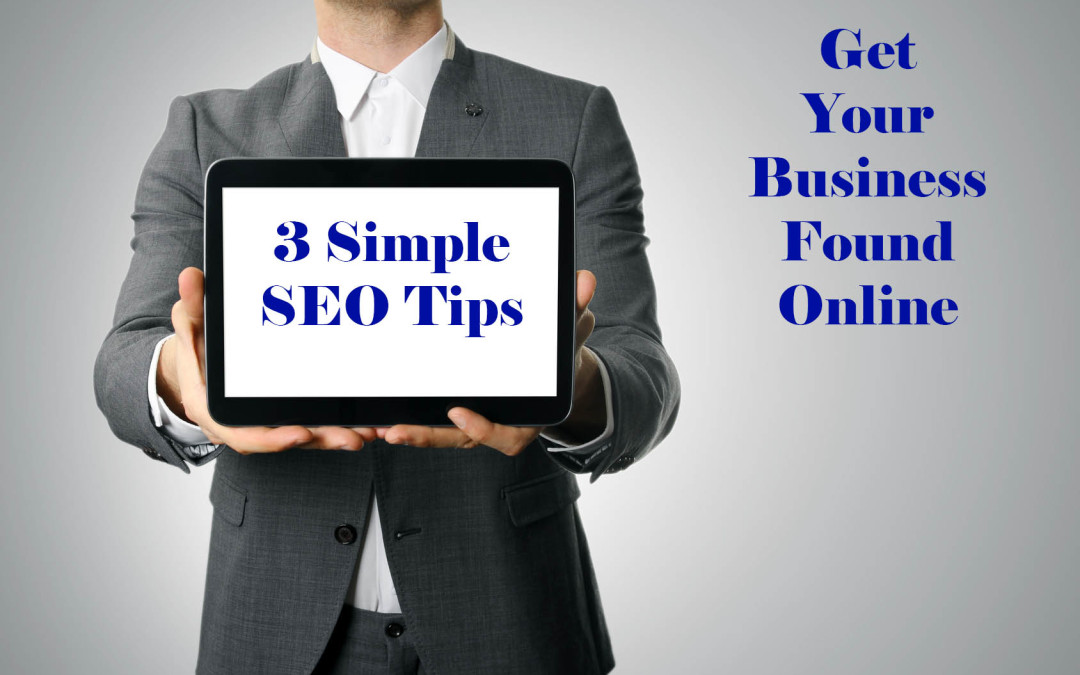In order to grow your business, you must be located online and ensure your website appears to prospects.
Before we get started with the tips, consider these important stats:
- 97% of consumers look for local businesses online
- 20–40% of all searches on Google are local
- 1.4 billion local business searches are made annually on the Yellow Pages site alone
- 40% of consumers say they will not buy a product or service if they can’t find the right info
about it online
3 Simple SEO Tips for Any Local Business in Houston
Tip #1
Get visibility with business listings
Business listings are simply your business’ name, address and phone number, published in a directory.
The directory can be either online (like YP.com) or offline (like the yellow pages directory). Many publishers allow businesses to add business listings for free. They also allow you to claim an existing business listing and add more information such as a link to your website or your hours of operation. You can usually omit your address if it isn’t important to the users. Common places where business listings are found online are yellow pages directories, local search sites (YP.com), review sites (Yelp), vertical directories (Lawyer.com) and map sites (Google Maps).
Consumers find business listings by using search engines or searching directly in the publisher’s directory.
When a consumer uses a search engine to find a business type (like a bakery) located within a specific area (like their city), the search engine often returns both business listings and web listings in the results. Often, the business listings rank higher than the regular web listings. When a consumer uses a local search site, a review site or a vertical directory, the publisher returns business listings, which may include additional information about your business such as a link to your website, hours of operation, ratings and reviews, photos, coupons and more. Many publishers allow consumers to add ratings, reviews or comments to your business listings.
Where to create online business listings:
a. YP.com – http://adsolutions.yp.com/free-listing-benefits
b. Google – https://www.google.com/business/placeforbusiness/
c. Yahoo! – http://search.yahoo.com/info/submit.html
d. Bing – https://www.bingplaces.com/
e. Yelp – https://biz.yelp.com/support/unlocking
There are hundreds of more sites where your listing could be published. If you don’t have time to review them all, consider using a listing management tool to help.
Keep listings accurate and consistent.
Avoid frustrating your customers with inaccurate business listings.
Missing or inconsistent information also harms your reputation with local search engine efforts.
Accuracy counts…Don’t sabotage your success with inaccurate information!
Monitor and respond to customer comments.
Managing your online reputation is important.
Although we hope that all your reviews are positive, here are some guidelines for how to respond to a negative review:
a. Respond appropriately: indicate concern for the customer’s experience, don’t take responsibility for the issue until you’ve had a chance to ascertain its validity.
b. Ask the person to contact you off-line to resolve the issue.
c. After the issue is resolved, you or the customer should go back online to post a comment about the resolution.
d. If you see a review that seems fraudulent, you can usually contact the publisher and have it removed.
Tip #2
Have a Well-Designed Website
It doesn’t need to be expensive or custom-built, it just needs to be useful and search engine optimized. We provide a four (4) point check list to make sure your website is practical.
The main information that consumers want: contact information, a summary of the types of products or services you provide and pricing (where it makes sense).
Since many consumers are using mobile devices to find local businesses you should also ensure that your website is optimized for smaller, mobile screens so that consumers can contact you once they find you.
Recent surveys show that over 60% of shoppers with tablets or smartphones report performing local searches on their device within the past week.
1. Check to see if your website is mobile responsive.
Use the browser on your desktop or laptop (internet explorer or Google chrome for example) to visit your website. If it looks exactly as it did at 100%, just a smaller version, then it is probably not mobile responsive. However, if your content changed or moved into a new order, then yes – your website is likely to be mobile responsive.
2. Help consumers find your website by making sure it is optimized for search engines.
Check by going to Google and typing into the search bar “site:url” (replacing “url” with the actual URL of your website).
If your website doesn’t show up, then Google doesn’t know your site exists. If your website does show up, then look at the number of results that Google returned and determine if this number is the same as the number of pages in your website. If it’s in the ballpark, you are fine, but if it is +/– 20% you may have a problem with your website and require further analysis.
3. Check if your site is relevant to the terms that your ideal customer will use to find you, or your type of business.
Check by identifying the words, terms, or phrases that your ideal customer may use when searching for your business and compare these to the words in your website.
The first place to look is the visible content on your site, but you also want to look at title tags and meta tags.
Title tags are descriptive titles for each page of your website that search engines use to organize search results. Meta tags describe each page of your website in more detail than title tags.
They give people searching more context about what they can expect to see when clicking the link to visit your page.
Here are tips for tagging:
- Keep title tags to 65 characters or less.
- Keep the most important keywords at the beginning of the description because search engines focus on these words most when ordering search results. Your website name or business name should be at the end.
- Make title tags ‘human readable’ instead of a thread of keywords, because they will show up for people to read.
- Each title tag should focus on the unique aspects of the page and be different from the title tags you create for other pages.
4. Check to see if the search engines prioritize your site over others.
Check by searching for your business using the terms that you previously identified.
Even if the search engine finds your website, and recognizes that it matches the terms the searcher entered, your website will not be at the top of the search results unless the search engine thinks your website is important.
In general, search engines make this decision by looking at the uniqueness of your content, the number of times a key word is used in your content and the number of other sites that reference your pages (also known as backlinks).
Links to your page are like votes for your website to get a higher ranking on search engines.
Here are practical optimization tips:
a. Focus on being important when people search for your business by name. SEO specialists invest hours of time and energy into helping your website become important for terms such as your type of business and descriptions of your products and
services. But the one term where you should always rank high is your business name.
b. When possible, use your business name in your url (mybusiness.com)
c. Make sure your business name and contact information is on your website.
d. Ensure that all of the business listings that link to your website are accurate.
e. If your website is for a local business, you can also get links by contacting the local Chamber of Commerce, writing articles for the local paper, interacting with local bloggers, and trading links with a small number of closely related sites.
Note that it’s not in your best interest to buy ads just to get links. Some search engines are actively against it. Don’t swap links with unrelated sites.
Tip #3
Add Great Content
Including important information about your business to both your website and your business listings helps consumers choose to do business with you. Great content is also part of a smart Search Engine Optimization (SEO) plan.
With these 3 steps, you can ensure your business is online, and gets found.
From a customer point of view, when a customer finds your website or your business listing they want enough information to determine if they should contact you or not.
This means that your site should look professional, but you don’t need to invest in flashy animation or highly customized designs.
This also means that your business listings should include information that helps set your business apart from other businesses listed in the directory, review site or local search site.
Here are 5 types of content you should always include:
1. Your business story in text, photo or video
The main points in a great business story are telling the reader what you do, what problem you solve, how your business is different than other businesses and how their life can be better for having done business with you.
Here is an example of a simple business story:
We are Suzie’s Garden. Our garden shop sells big box stores so that our customers can have the garden of their dreams.
Tell your story with photos and videos to make a real impact.
2. Specific information about the products or services you provide
This is not a place for keyword stuffing since these terms may not influence your ranking, but this is the place to let the reader know what they can expect if they contact you.
3. Pricing information
Disclosing pricing is a good way to attract qualifi ed customers to the next point of sale. Depending on your type of business you may want to provide actual prices or you may want to simply indicate if you are a leader in low prices vs a provider of high quality, custom services.
4. Raves and recommendations from your customers
Put recommendations from your best customers on your website. The easiest way is to include a written quote, but it’s even better if your customers contribute pictures of themselves enjoying the results of your products or services.
Ask customers to add a review or recommendation on your favorite directory or local search
sites: YP.com, Yelp, Angie’s List, etc. Reviews are your best friend – it’s the online form of word
of mouth marketing.
5. Contact information
Depending on your type of business you may want customers to contact you by phone, at your
location, or online (email).
a. Make it easy for your customer to find your contact information by including it on every
page of your website.
b. Make it easy for them to visit you by including maps or driving directions. A picture of the
front of your business makes it easy for them to recognize you when they get there.
c. Make it easy for them to email you by including an email form on your website. This way
you’ll know that they’ve included all the information that you need to provide great service.
Summary of SEO Tips
Ensure your business is online and gets found is done easily by following these three steps.
1. Get visibility with business listings.
There are lots of places consumers look to find your business including YP.com, Google maps, Yelp and more. Get your business listed…Keep it accurate…Monitor and respond to customer comments.
2. Have a practical website.
It doesn’t need to be expensive or custom-built, it just needs to be useful and search engine optimized.
Check that it is mobile optimized…Check that search engines can find it…Check that search engines think it is relevant…Check that search engines prioritize your site.
3. Add great content.
Including important information about your business on both your website and your business listings helps consumers choose to do business with you. Great content is also part of a smart Search Engine Optimization (SEO) plan.
Always include:
- Your business story in text, photo or video
- Specific information about the products or services you provide
- Pricing information
- Reviews and recommendations from your customers
- Contact information
If you need further help, please contact us today for more information on how you can get your business online!



